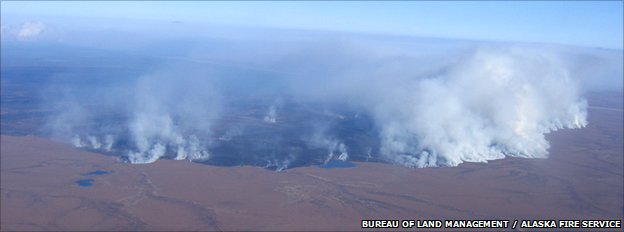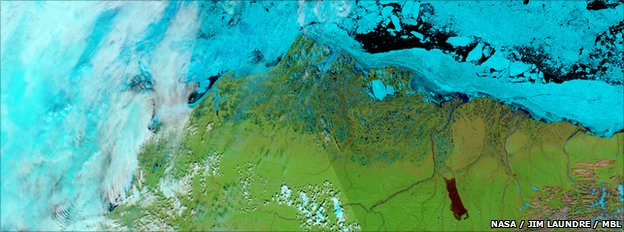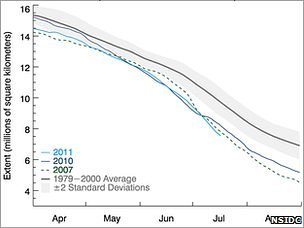
Tefnut's Environmental and Drought News Article

By Richard Black Environment correspondent, BBC News
28 July 2011 Last updated at 12:03 GMT

In the summer of 2007, more than 1,000 sq km of Alaskan tundra burned near Anaktuvuk River
An exceptional wildfire in northern Alaska in 2007 put as much carbon into the air as the entire Arctic tundra absorbs in a year, scientists say.
The Anaktuvuk River fire burned across more than 1,000 sq km (400 sq miles), doubling the extent of Alaskan tundra visited by fire since 1950.
With the Arctic warming fast, the team suggests in the journal Nature that fires could become more common.
If that happens, it could create a new climate feedback, they say.
Fires in the tundra are uncommon because the ground is covered in snow and ice for large periods of the year.
"Melting can lead to other huge changes... releasing carbon that's been frozen since the Pleistocene"
Michelle Mack University of Florida
Temperatures are low even in summer, and the ground can also remain wet after the ice has melted.
But 2007 saw unusually warm and dry conditions across much of the Arctic - resulting, among other things, in spectacularly fast melting of Arctic sea ice.
This created conditions more conducive to fire, and when lightning struck the tundra in July, the Anaktuvuk River fire ignited.
"Most tundra fires have been very small - this was an order of magnitude larger than the historical size," said Michelle Mack from the University of Florida in Gainesville, who led the research team on the Nature paper and is currently conducting further field studies in Alaska.
"In 2007, we had a hot, dry summer, there was no rain for a long period of time.
"So the tundra must have been highly flammable, with just the right conditions for fire to spread until the snow in October finally stopped it."

Nasa satellites image Arctic ice, water, land - and the Anaktuvuk fire, the black portion at bottom-right
According to the team's calculations, the statistics of the fire are remarkable.
It is the largest on record, doubling the cumulative area burned since 1950.
It put carbon into the atmosphere about 100 times faster than it usually escapes from the ground in the Arctic summer, and released more than 2 million tonnes.
Although a small contribution to global emissions, this is about the same amount as the entire swathe of tundra around the Arctic absorbs in a single year.

The melting of Arctic sea ice is currently on course to break the record of 2007
There is some vegetation on the summer lands, which did burn; but the main fuel is carbon in the ground itself.
The Anaktuvuk fire burned down to a maximum depth of 15cm (6in), and was burning carbon sequestered away over the last 50 years.
What this implies for the future is uncertain.
Climate models generally predict warmer temperatures across the Arctic, which could increase the frequency of fires and so a net loss of carbon into the atmosphere - reinforcing global warming.
On the other hand, plant life could flourish under these conditions, potentially increasing absorption and sequestering of carbon from the atmosphere.
In a news story published well before the Nature paper came out, another of the US research team, Gaius Shaver from the Marine Biological Laboratory in Woods Hole, said the northern region of Alaska could become "vastly different from the frozen, treeless tundra of today.
"And it's one that may feed back positively to global climate change."
On reflection
Another impact of the fire that has yet to be fully assessed is that the blackened soil absorbs more solar energy than normally vegetated tundra.
This abets melting of the permafrost layer below.
"Once permafrost melts beyond a certain depth on a slope, then all of the organic layer slides down the slope like a landslide," Dr Mack told BBC News.
"This whole issue of melting can lead to other huge changes in drainage, in areas of wetlands - releasing carbon that's been frozen since the Pleistocene [Epoch, which ended more than 10,000 years ago]."
The latest data on Arctic sea ice, meanwhile, reveals that 2011 could well see a melting season that will beat the 2007 record.
Currently, a smaller area of sea is covered in ice than at the same point in 2007, which the US National Snow and Ice Data Center (NSIDC) ascribes to "persistent above-average temperatures and an early start to [the] melt".
Source: BBC News
© 2010-2026 Bill McNulty All Rights Reserved